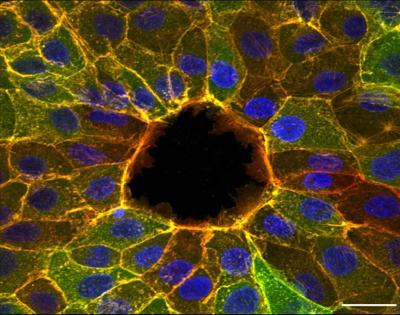Research by a civil engineer from the University of Waterloo is helping shed light on the way wounds heal and may someday have implications for understanding how cancer spreads, as well as why certain birth defects occur.
Professor Wayne Brodland is developing computational models for studying the mechanical interactions between cells. In this project, he worked with a team of international researchers who found that the way wounds knit together is more complex than we thought. The results were published this week in the journal, Nature Physics.
"When people think of civil engineering, they probably think of bridges and roads, not the human body," said Professor Brodland. "Like a number of my colleagues, I study structures, but ones that happen to be very small, and under certain conditions they cause cells to move. The models we build allow us to replicate these movements and figure out how they are driven."

This image depicts a wound in the process of healing.The drawstring fragments along the wound edge are shown in bright yellow, the cell extensions associated with crawling are red, and the cell nuclei are blue.
(Photo Credit: Ester Anon)
When you cut yourself, a scar remains, but not so in the cells the team studied. The researchers found that an injury closes by cells crawling to the site and by contraction of a drawstring-like structure that forms along the wound edge. They were surprised to find that the drawstring works fine even when it contains naturally occurring breaks.
This knowledge could be the first step on a long road towards making real progress in addressing some major health challenges.
"The work is important because it helps us to understand how cells move. We hope that someday this knowledge will help us to eliminate malformation birth defects, such as spina bifida, and stop cancer cells from spreading," said Professor Brodland.
Source: University of Waterloo